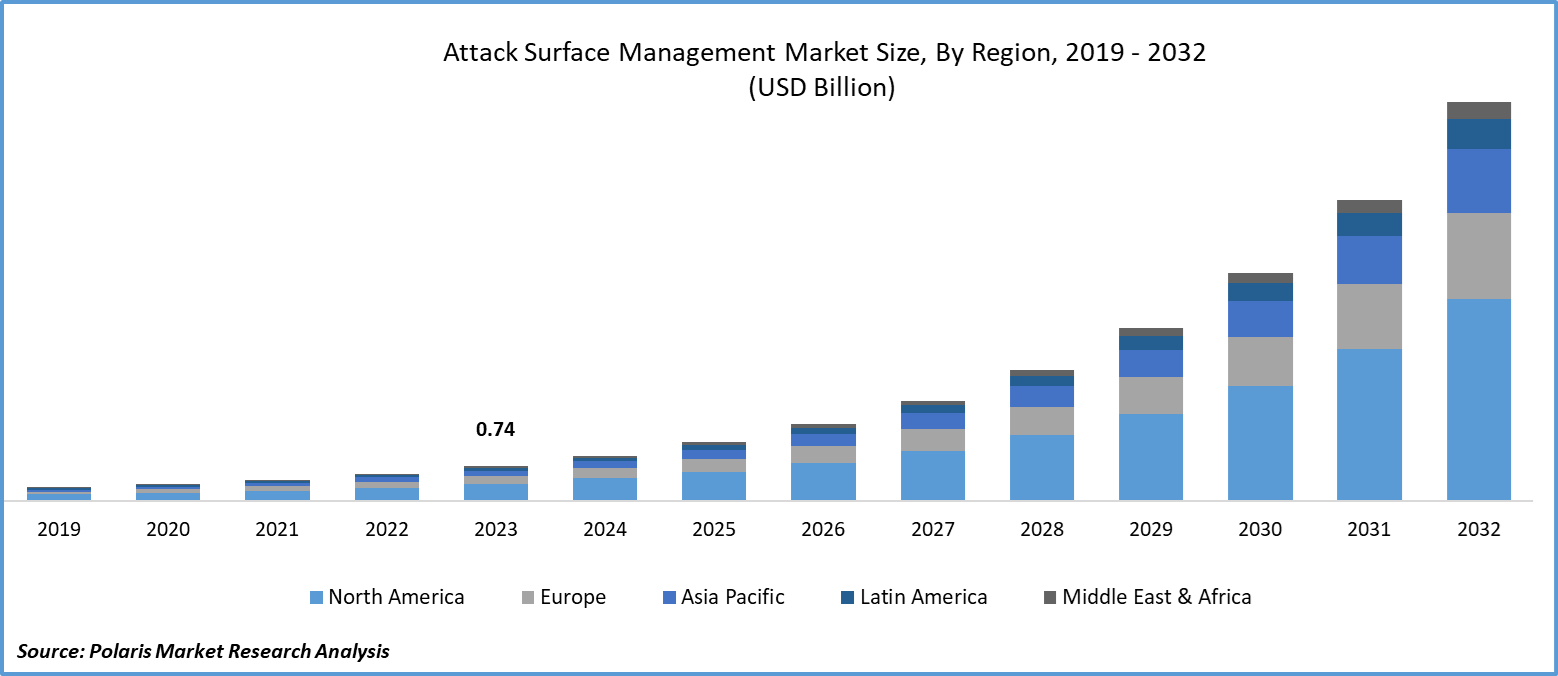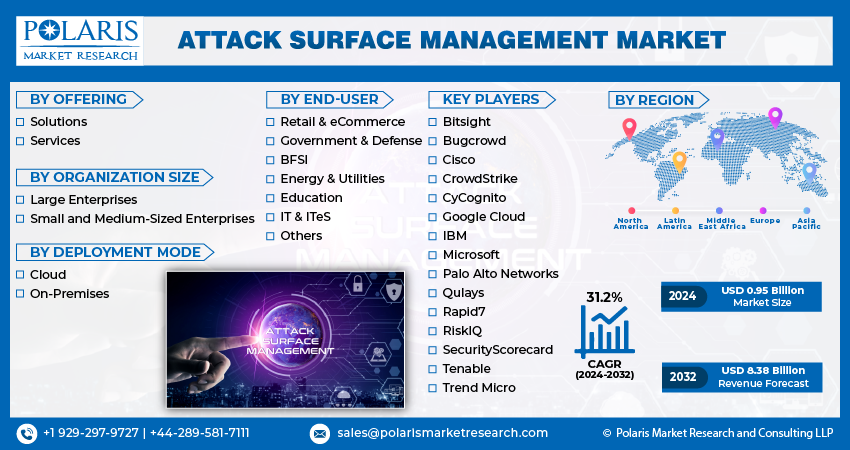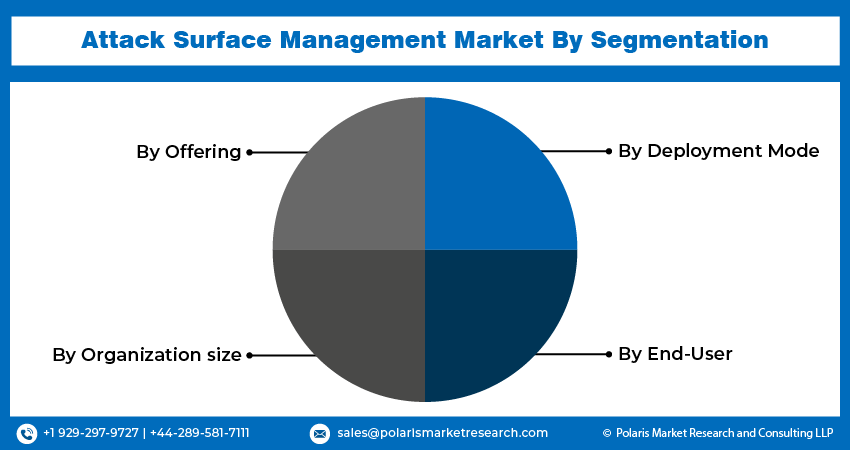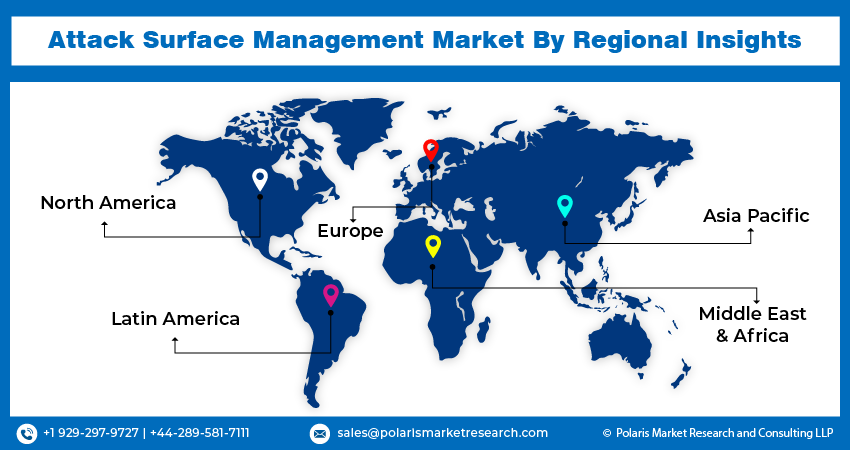
Attack Surface Management Market Share, Size, Trends, Industry Analysis Report, By Offering (Solutions, Services); By Organization Size; By Deployment Mode (Cloud, On-Premises); By End-User; By Region; Segment Forecast, 2024 - 2032
- Published Date:May-2024
- Pages: 116
- Format: PDF
- Report ID: PM4919
- Base Year: 2023
- Historical Data: 2019-2022
Report Outlook
Attack surface management market size was valued at USD 0.74 billion in 2023. The market is anticipated to grow from USD 0.95 billion in 2024 to USD 8.38 billion by 2032, exhibiting the CAGR of 31.2% during the forecast period
Attack Surface Management Market Overview
The attack surface management market is witnessing continuous growth owing to its involvement in the ongoing process of identifying, analyzing, ranking, addressing, and overseeing the cybersecurity weaknesses and possible entry points that form the attack surface of a company. Additionally, proactive measures such as asset discovery and classification aid in gaining a comprehensive view of the entire attack surface, allowing for targeted risk assessment and efficient allocation of resources for remediation efforts. The software for managing attack surfaces utilizes up-to-date information on known risks, making the process of resolving issues easier and faster. Efficient workflows enable users to monitor the advancement and pinpoint the exact moment when the remediation is finished.

To Understand More About this Research: Request a Free Sample Report
For instance, in March 2024, Claroty and Axonius joined forces to provide comprehensive attack surface management for cyber-physical systems in the enterprise. This partnership aims to enhance security across various networks, such as IT, cloud, and the Extended Internet of Things (XIoT), which encompasses a wide range of CPS components like OT, IoT, BMS, and IoMT.
Effective attack surface management relies on collaboration among cross-functional teams, including IT, security, and development, to enable swift responses to emerging threats and changing attack methods. Ultimately, a proactive and adaptable approach to attack surface management is crucial for protecting organizations against cyber threats in today's intricate digital environment.
In recent years, External Attack Surface Management (EASM) has been developed. This modern technology is designed to concentrate on the vulnerabilities and threats associated with an organization's external or internet-facing IT assets, also known as the digital attack surface. On the other hand, ASM deals with vulnerabilities in an organization's physical and social engineering attack surfaces, including malicious insiders and the lack of proper end-user training to combat phishing scams.
Attack Surface Management Market Dynamics
Market Drivers
Rising IoT Integration
The rising awareness among key players across the globe regarding the challenges faced by attack surface management, hence, integrating dedicated capabilities for IoT asset discovery and vulnerability assessment can be done profoundly. It focuses on creating strong mechanisms that can effectively identify, assess, and handle the security of IoT devices within an organization's digital ecosystem. This progression guarantees that security teams can effectively address the distinct security concerns linked to the wide array of IoT devices.
Rising Adoption of AI and ML
The progress made in AI and ML has driven the development of attack surface management, leading to the introduction of predictive analysis, anomaly detection, and automated response actions. These advancements enable security teams to go beyond reactive measures and can foresee potential threats. Technological advancements and analytics to promptly identify and eliminate threats in real time are possible. By integrating these capabilities, organizations can not only respond quickly to known threats but also proactively anticipate and overcome emerging challenges.
Market Restraints
Complexity of Digital Ecosystems
Modern organizations operate in diverse and interconnected environments, encompassing cloud services, IoT devices, and third-party applications. This complexity exponentially expands the attack surface, making it difficult to obtain a comprehensive view of all potential vulnerabilities and threats. Moreover, the dynamic nature of digital ecosystems, characterized by frequent updates, configuration changes, and new deployments, further complicates the task of maintaining an accurate and up-to-date understanding of the attack surface. Consequently, organizations face challenges in effectively prioritizing and addressing security risks, resulting in heightened exposure to cyber threats and potential data breaches.

Report Segmentation
The market is primarily segmented based on offering, organization size, deployment mode end-user, and region.
|
By Offering |
By Organization size |
By Deployment Mode |
By End-User |
By Region |
|
|
|
|
|
To Understand the Scope of this Report: Speak to Analyst
Attack Surface Management Market Segmental Analysis
By Offering Analysis
- The solutions segment led the market with substantial revenue share, largely attributable to its ability to thoroughly identify, evaluate, and address potential vulnerabilities within its digital infrastructure. This strategy involves the use of advanced tools like vulnerability scanners, penetration testing frameworks, and threat intelligence platforms to monitor and analyze the attack surface continuously. Furthermore, organizations enforce strong configuration management practices to ensure that all systems and applications comply with security best practices and regulatory requirements.
- The services segment is projected to grow at a CAGR during the projected period, mainly driven by comprehensive assessments, penetration testing, and red team engagements conducted by skilled cybersecurity professionals to identify and exploit potential weaknesses in the organization's digital infrastructure. Additionally, managed security services providers (MSSPs) offer ongoing monitoring, threat intelligence analysis, and incident response support to detect and mitigate security threats across the attack surface proactively. Furthermore, consulting services provide strategic guidance and customized solutions for optimizing attack surface management processes, aligning security initiatives with business objectives, and enhancing overall cybersecurity posture.
By Deployment Mode Analysis
- The on-premises segment accounted for the largest market share and is likely to retain its market position throughout the forecast period. On-premises solutions allow for detailed customization and integration with current security frameworks, facilitating personalized risk evaluations and swift responses to emerging threats. This method provides direct oversight of hardware, software, and network setups, ensuring that sensitive data remains within the organization's confines. On-premises solutions may necessitate a substantial initial investment and continuous upgrades.
- The cloud segment is poised for rapid growth in the coming years, driven by increasing demand. Cloud-based solutions offer scalable and centralized monitoring of digital assets, enabling real-time detection and response to security threats across diverse environments. These platforms provide enhanced visibility, automation, and collaboration, thereby streamlining risk assessment and mitigation efforts for a stronger cybersecurity posture.
By End-User Analysis
- The BFSI (Banking, Financial Services, and Insurance) segment held a significant market share, which is highly accelerated as it stands strict regulatory demands and valuable assets call for a specialized cybersecurity approach. Thorough risk evaluations and compliance audits are carried out to ensure compliance with industry standards like GDPR and PCI DSS. Collaborating with cybersecurity professionals and participating in information-sharing initiatives within the sector further bolsters the resilience of BFSI entities against emerging cyber risks.
- The IT & ITeS segment is witnessing the fastest growth with a healthy CAGR owing to companies utilizing a variety of technologies and platforms to oversee, evaluate, and minimize security threats within their digital framework. This includes implementing advanced security measures like intrusion detection systems, endpoint protection software, and network monitoring tools to identify and address possible risks. Furthermore, thorough vulnerability assessments and penetration tests are carried out to pinpoint flaws in software, hardware, and network setups.

Attack Surface Management Market Regional Insights
The North America Region Dominated the Global Market with the Largest Market share
The North America region dominated the global market with the largest market share and is expected to maintain its dominance over the anticipated period. The growth of the segment market can be largely attributed to the rapid increase in conducting an analysis of the attack surface, allowing for the identification of dangers and weaknesses within the infrastructure, enabling it to prioritize and address issues effectively. By uncovering unmanaged assets and other hidden risks, the implementation of impactful solutions can enhance security with minimal resource allocation. Identifying all external assets, such as shadow IT, forgotten infrastructure, and misconfigurations. Utilizing automated IT asset discovery to continuously map out the organization's external attack surface and maintain an up-to-date inventory is the main driving factor driving the expansion of this market in this region.
The Asia Pacific region is expected to be the fastest growing region with a healthy CAGR during the projected period, owing to the growing consumption of clean energy and rising energy efficiency among many consumers, along with the implementation of reducing greenhouse gas emissions, especially in countries like Germany, France, and the United Kingdom.

Competitive Landscape
The attack surface management market is fragmented and is anticipated to witness competition due to several players' presence. Major service providers in the market are constantly upgrading their technologies to stay ahead of the competition and to ensure efficiency, integrity, and safety of the customer’s data ensuring no breach. These players focus on technology, product upgrades, and collaboration to gain a competitive edge over others in this domain to capture a significant market share.
Some of the major players operating in the global market include:
- Bitsight
- Bugcrowd
- Cisco
- CrowdStrike
- CyCognito
- Google Cloud
- IBM
- Microsoft
- Palo Alto Networks
- Qulays
- Rapid7
- RiskIQ
- SecurityScorecard
- Tenable
- Trend Micro
Recent Developments
- In April 2024, Edgio introduces Attack Surface Management to provide ongoing threat protection. Edgio ASM allows companies to minimize the risk associated with web application vulnerabilities through constant detection of web assets, identification of security risks, and effective remediation management.
- In January 2024, Outpost24, a renowned company specializing in cyber risk management and threat intelligence solutions, recently unveiled the incorporation of credential threat intelligence into its external attack surface management solution. By leveraging the advanced capabilities of the Outpost24 Threat Intelligence solution, this innovative data integration empowers customers to promptly identify stolen credentials, thereby significantly reducing the impact of potential attacks.
Report Coverage
The attack surface management market report emphasizes on key regions across the globe to provide better understanding of the product to the users. Also, the report provides market insights into recent developments, trends and analyzes the technologies that are gaining traction around the globe. Furthermore, the report covers in-depth qualitative analysis pertaining to various paradigm shifts associated with the transformation of these solutions.
The report provides detailed analysis of the market while focusing on various key aspects such as competitive analysis, offering, organization size, deployment mode end-user and their futuristic growth opportunities.
Attack Surface Management Market Report Scope
|
Report Attributes |
Details |
|
Market size value in 2024 |
USD 0.95 billion |
|
Revenue forecast in 2032 |
USD 8.38 billion |
|
CAGR |
31.2% from 2024 – 2032 |
|
Base year |
2023 |
|
Historical data |
2019 – 2022 |
|
Forecast period |
2024 – 2032 |
|
Quantitative units |
Revenue in USD billion and CAGR from 2024 to 2032 |
|
Segments covered |
By Offering, By Organization size, By Deployment Mode, By End-User, By Region |
|
Regional scope |
North America, Europe, Asia Pacific, Latin America, Middle East & Africa |
|
Customization |
Report customization as per your requirements with respect to countries, region, and segmentation. |
